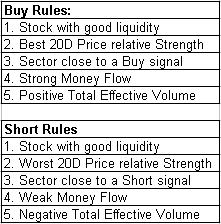-
Stock Selection Page
Billy and I have worked in the past Month to revive the stock selection that was developed a few years ago when the EV method was first published.
The main idea had been to use a top-bottom approach: going from market to sector and then stock signal and not the opposite. We are keeping this idea and will therefore rely on the 20DMF to produce the main market direction signals.
The Buy/Sell rules are set below. You will note that we did not use the Active Boundaries indicator, because of a lack of past data. You will also note that we instead use the price relative strength indication, which has been a favorite of Billy for many years as well as a Money Flow measure - the money flow being a moving average of the Price * Volume, which is different from an Effective Volume based MF approach. This method hence combines traditional measures to the EV method.
The sectors measure uses the "number of days" approach that we have developed last year.
This means that this stocks selection process is more advanced than any of the filters that are available in the filters section.

The analysis period was set between June 2011 and May 2013, which is about a two years long period.
We then used two independent periods to test the algos: between August 2007 and March 2009 for the Bearish period and between March 2009 and June 2011 for the bullish period.
We used SPY as a benchmark, although we might have used IWM, as SPY has been influenced by the poor Euro zone economic perspectives since June 2011.
1. 20DMF Buy Signals
As we can see in the table below, the Buy signals generated positive returns that are very impressive when the market is in a bullish mode. During the bear market earlier than 2009, the method did about as bad as SPY.
You will note that since June 2011, shorting the worst picks would have led to much higher losses than the profits generated by buying the best picks. This is due to the shorts covering rally that the Fed liquidity has generated.

2. 20DMF Buy Oversold signals
As we can see below, in an oversold market, it is better to buy the worst picks than the best ones, due to the impetus offered by the shorts covering activities.
However, buying leveraged ETFs (SSO for example would work better than buying the stocks with the worst technicals)

3. 20DMF Short signals
Stock picking during short signals works much better during strong bear markets, but this information is available only in hindsight. However, in general, we can see that buying a double leveraged ETF such as SDS would have led to better returns over the whole period.

4. 20DMF Cash signals
This is probably the most tricky environment to trade stock picks. The EV method shows that we need to favor short trades during a bear market, but it is indecisive during the two bull market phases. We would advise to short individual stocks, but hedge with long SDS positions.

What will we do from here?
Since the 20DMF RT issues its signal during the day, we will do our best to produce the best long/short trading ideas before the market closes on a day of signal change. Once these ideas have been produced, we will follow them until the next signal change.
We will also produce more regular stock selections and advise for rotation whenever necessary.
This new system will be ready hopefully before July and will be made available here at no extra charge.
Pascal
 Posting Permissions
Posting Permissions
- You may not post new threads
- You may not post replies
- You may not post attachments
- You may not edit your posts
Forum Rules




 Reply With Quote
Reply With Quote